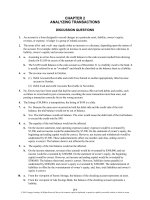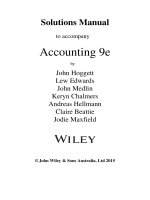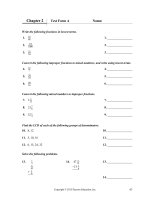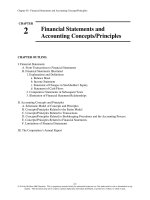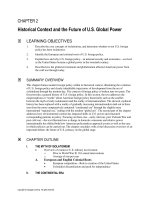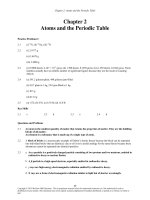Test band and solution of analysis of FInancial statements (2)
Bạn đang xem bản rút gọn của tài liệu. Xem và tải ngay bản đầy đủ của tài liệu tại đây (249.3 KB, 4 trang )
Solutions
CHAPTER 2
2-1
Pr esent $1,312,500 2.5
current ratio $525,000
Minimum = $1,312,500+ΔNP =2.0×
current ratio $525,000+ΔNP
$1,312,500 + ΔNP = $1,050,000 + 2ΔNP
ΔNP = $262,500.
Short-term debt can increase by a maximum of $262,500 without violating a 2-to-1 current ratio,
assuming that the entire increase in notes payable is used to increase current assets. Because
we assumed that the additional funds would be used to increase inventory, the inventory account
will increase to $637,500 = $375,000 + $262,500, and current assets will total $1,575,000.
Quick ratio = ($1,575,000 - $637,500)/$787,500
= $937,500/$787,500
= 1.19x
2-2
(1)
Current assets
3.0
Current liabilities
$810,000
3.0
Current liabilities
(2)
Current liabilities = $270,000
Current assets - Inventorie s
1.4
Current liabilities
$810,000 Inventorie s
1 .4
$270,000
(3)
Inventories = $432,000
Current assets = Cash + Marketable securities + Accounts receivable + Inventories
$810,000 = $120,000 + Accounts receivable + $432,000
Accounts receivable = $258,000
(4)
(5)
Cost of goods sold
5.0
Inventory
CGS
5 .0
$432,000
CGS = $2,160,000
CGS = 0.86 (Sales)
Sales
1
$2,160,000
$2,511,628
0.86
Solutions
(6) DSO
2-3
Accounts receivable
$258,000
37 days
Sales / 360
$2,511,628 / 360
TIE = EBIT/INT, so find EBIT and INT
Interest = $500,000 x 0.1 = $50,000
Net income = $2,000,000 x 0.05 = $100,000
Taxable income (EBT) = $100,000/(1 - T) = $100,000/0.8 = $125,000
EBIT = $125,000 + $50,000 = $175,000
TIE = $175,000/$50,000 = 3.5 x
2-4
ROE = NI/Equity
Now we need to determine the inputs for the equation from the data that were given. On the left
we set up an income statement, and we put numbers in it on the right:
Sales (given)
- Cost
EBIT (given)
- INT (given)
EBT
- Taxes (30%)
NI
$10,000
na
$ 1,000
( 300)
$ 700
( 210)
$ 490
Now we can use some ratios to get some more data:
Total assets turnover = 2.0 = Sales/TA; TA = Sales/2 = $10,000/2 = $5,000
Debt/TA = 60%; so Equity/TA = 40%; therefore, Equity
= TA x Equity/TA
= $5,000 x 0.40 = $2,000
Alternatively, Debt = TX x Debt/TA = $5,000 x 0.6 = $3,000; Equity = TA – Debt = $5,000 $3,000 = $2,000
ROE = NI/E = $490/$2,000 = 24.5%, and ROA = NI/TA = $490/$5,000 = 9.8%
2-5
Net cash flow = $180,000 + $50,000 = $230,000
2-6
a.
NI
= (Sales – Operating costs – Interest expense)(1-T)
$650,000 = (Sales - $1,500,000 - $300,000 – 0)(1 – 0.35)
Sales
b.
$650,000
($1,500,000 $300,000) $2,800,000
0.65
Net cash flow = $650,000 + $300,000 = $950,000
2
Solutions
2-7
We are given ROA = 3% and Sales/Total assets = 1.5x
From DuPont equation: ROA
3%
Profit margin
=
=
=
Profit margin x Total assets turnover
Profit margin (1.5)
3%/1.5 = 2%.
We can also calculate Zumwalt’s debt ratio in a similar manner, given the facts of the problem.
We are given ROA, which is NI/A and ROE, which is NI/Equity; if we use the reciprocal of ROE
we have the following equation:
Equity
NI
Equity
1
=
= 3.0%
= 0.60 = 60%
A ssets A ssets
NI
0.05
Debt/Assets = 1 - Equity/Assets = 1 - 0.60 = 0.40 = 40.0%
Thus, Zumwalt's profit margin = 2% and its debt ratio = 40%.
2-8
a.
Current ratio = CA/CL = 3.5, thus CL = CA/3.5
CA = $73,500
CL = $73,500/3.5 = $21,000
b.
Quick ratio = (CA – Inventory)/CL = 3.0, thus Inventory = CA – 3CL
Inventory = $73,500 – 3($21,000) = $10,500
2-9
TA = $500,000
ROA = 6.0%
ROE = 8.0%
2-10
a.
ROA = NI/TA =NI/$500,000 = 0.06, thus NI = 0.06($500,000) = $30,000
b.
ROE = NI/CE = $30,000/CE = 0.08, thus CE = $30,000/0.08 = $375,000
TA turnover = 3.0
Net profit margin = 4.0%
ROE = 15.0%
a.
ROA = NI/TA = NI/Sales x Sales/TA = Net profit margin x Total assets turnover
ROA = 4.0% x 3.0 = 12.0%
b.
ROE = ROA x Equity multiplier = 12.0% x Equity multiplier = 15.0%
Equity multiplier = 15.0%/12.0% = 1.25
3
Solutions
Equity multiplier = TA/CE, which is the inverse of the proportion of the firm that is
financed with common equity. Thus, the portion of total assets that is financed with
equity is 1/1.25 = 0.8 = 80.0%
2-11
Debt ratio = 60% = TL/TA
Total assets turnover = 1.8x = Sales/TA
Days sales outstanding = 40 days = AR/[Sales/360]
Return on Equity (ROE) = 20.0% = NI/CE
Return on Assets (ROA) = 8.0% = NI/TA
TL = $90,000
Based on the information provided in the problem, we can compute the following:
(1)
TA = TL/0.60 = $90,000/0.60 = $150,000
(2)
Common equity = CE = TA – TL = $150,000 - $90,000 = $60,000
(3)
Sales = 1.8(TA) = 1.8 x $150,000 = $270,000
(4)
Net income = NI = TA x 0.08 = $150,000 x 0.08 = $12,000
Alternatively, NI = CE x 0.2 = $60,000 x 0.2 = $12,000
(5)
40 = AR/[Sales/360] = AR/[$270,000/360]
AR = 40 x [$270,000/360] = 40 x 750 = $30,000
2-12
Currently, ROE is ROE1 = $9,200/$90,000 = 0.102 = 10.2%
The current ratio will be set such that 2.0 = CA/CL. CL is $27,500, and it will not change, so we
can solve to find the new level of current assets: CA = 2.0(CL) = 2.5($27,500) = $55,000. This
is the level of current assets that will produce a current ratio of 2.0x.
At present, current assets amount to $110,000, so they can be reduced by $55,000 =
$110,000 – $55,000. The reduction in current assets will be achieved by selling $55,000 in
inventories.
If the $55,000 generated is used to retire common equity, then the new common equity
balance will be $90,000 – $55,000 = $35,000.
Assuming that net income is unchanged, the new ROE will be ROE2 = $9,200/$35,000 = 0.263
= 26.3%. Therefore, ROE will increase by 16.1% = 26.3% – 10.2%.
4
